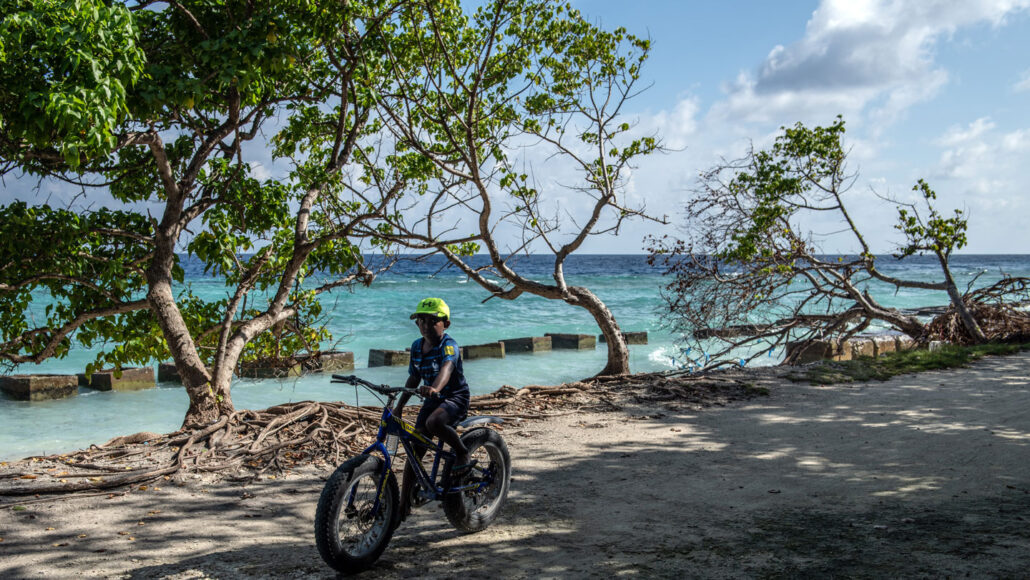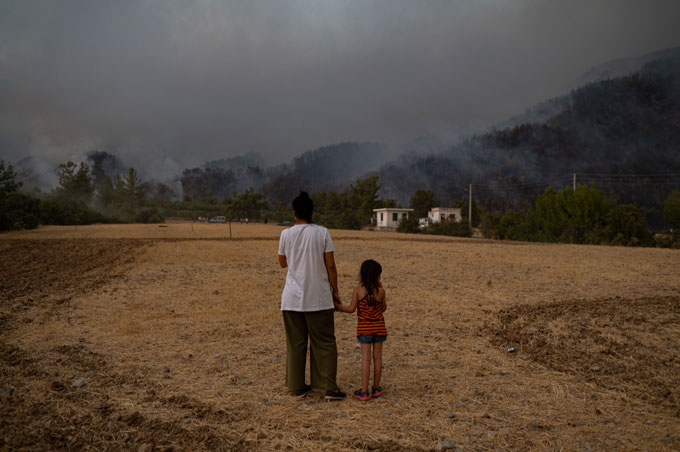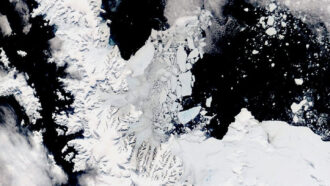UN report calls for two-pronged approach to slow climate impacts
It says the time to cut emissions and avoid the most disastrous impacts is closing fast

In the Maldives (shown), the island nation’s communities are losing their coastlines to erosion and rising sea levels. These and others who are most vulnerable to climate change are being hit the hardest, a new United Nations’ climate report finds.
Carl Court/Getty Images
By Nikk Ogasa
As Earth’s climate has been changing, people have been forced to adapt to growing environmental problems. These include increasing rates of drought, flooding, wilder storms and extreme temps. At the same time, scientists note that we also have to limit the release of the greenhouse gases that underlie much of that warming. In fact, neither by itself will end the worsening climate impacts. That’s the conclusions of hundreds of the world’s scientists in a new report.
It was released February 28 by International Panel on Climate Change, or IPCC. It’s part of the United Nations.
A global effort must both drastically curb greenhouse-gas emissions and adapt to climate change, the new report says. Nothing less will stave off the most disastrous impacts of our warming climate.
The IPCC’s warning comes as the effects of climate change on people and nature are playing out across the globe in a broader and far more severe manner than had been predicted.
Some people had argued that “we can just adapt our way out of climate change,” says Anne Christianson. Adapt enough, they’d said, and emissions of greenhouse gases might not have to be cut. But the new report is “the strongest rebuttal that we’ve seen yet of this idea,” she says. Christianson directs the international climate policy program at the Center for American Progress. It’s an independent policy institute in Washington, D.C.
IPCC recruited some 270 scientists from 67 countries to review more than 34,000 studies. The new report is based on what they learned. It details how the impacts of climate change are playing out. It also assessed how well communities and regions will likely be able to adapt to the coming environmental changes. Some modern examples of such adaptation include the building of urban rain gardens and changing the way people building homes and cities.
Many such programs show real promise, the report said. It added, however, that such programs tend to be small and poorly funded. These programs also tend to come as a response to existing problems. It would be smarter, the report says, to instead adopt adaptive practices before crises develop.

Much of the world faces big, growing problems
Today, some 3.3 billion to 3.6 billion people remain highly vulnerable to climate risks, the report finds. That’s approaching half the world’s population. The need for adaptation is greatest — and growing larger — in low-income regions. This is especially true for parts of Africa, South Asia, small island nations and Central and South America. People in these areas should be involved in setting new plans to tackle climate problems. “We can no longer just make these decisions at the highest level,” says Christianson. “We need to include [others],” she says, such as “Indigenous groups, local communities and those who are most as at risk for climate change — such as women, racial minorities, the elderly and children.”
Last August, the IPCC put out another report. It detailed the trajectory of climate changes now underway. That report’s authors stated loud and clear that there was no time to waste. By 2030, greenhouse-gas emissions need to be cut in half, compared with 2017 levels. If not, they warned, the ability for human societies and nature to adapt will severely deteriorate. But that report did offer a bit of good news: Its authors reported data showing that if all greenhouse-gas emissions were to cease today, global temperatures would stop rising in about three years. That’s far sooner than the 30 to 40 years once thought. In other words, people can make a big difference in very little time.
But even that wouldn’t end all climate-change impacts now underway. Sea levels will continue to rise for decades, the report found. They’re being driven in part by the runaway melting of Greenland’s ice sheet. By 2050, U.S. coasts will have seen a sea-level rise of 25 to 30 centimeters, or roughly one foot. That’s what the National Oceanic and Atmospheric Administration now estimates in a February 2022 report.
Extreme weather has already led to mass deaths of corals and other animals and trees. Some species have been pushed toward the brink of extinction. What’s more, climate change is forcing some people to relocate. It’s stressing out many people, including kids. And it’s been spreading disease as vectors, such as mosquitoes, shift to new, warmer sites.
Adaptation is especially needed in cities, the new report finds. Cities are growing — and fast. In less than 30 years, cities are expected to house two-thirds of the world’s population. Among their new residents: climate refugees from elsewhere. People in these urban areas are becoming increasingly vulnerable to things like extreme heat, floods and intense storms.
Outside of cities, ecosystems have been breaking down, the report notes. Farmers are finding it increasingly challenging to grow crops as soils dry, the air warms, rains become undependable — and storms, when they come, prove especially severe. People who make their living fishing are being forced to travel greater distances in search of species that are altering their natural ranges. Those fish are looking for cooler waters as more and more of the ocean experiences record heat.
Key to adapting to all of these impacts is preserving natural ecosystems or restoring damaged ones, the report states. Conserving 30 to 50 percent of the planet’s land and aquatic ecosystems will help support biodiversity.
Protecting nature should be a priority
“The truth is that nature can be our savior,” said Inger Andersen. “But only if we save it first.” Andersen is executive director of the U.N. Environment Programme. It’s based in Nairobi, Kenya. She spoke at a February 28 news conference announcing the report’s release.
Nature provides “services” on which people rely. These include flood control and storing some of the carbon dioxide that would otherwise warm the planet. But the report notes that many of these natural systems start to break down at about 1.5 degrees Celsius (2.7 degrees Fahrenheit) above temperatures typical of the late 1700s. And the window to prevent that much warming is closing. “We are on a trajectory to losing many of these systems and the services they provide” says Borja Reguero. He’s a coastal science researcher who reviewed the report. He works at the University of California, Santa Cruz.
Adelle Thomas agrees. A lead author of one of the new report’s chapters, she spoke at a February 27 news briefing. “We simultaneously need to reduce our greenhouse-gas emissions, adapt to reduce the risks of climate change and also address losses and damages that are already being experienced,” she says. A climate scientist, she works at the University of the Bahamas in Nassau. And, she stressed, “We have a very limited amount of time left to do this.”







